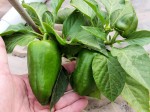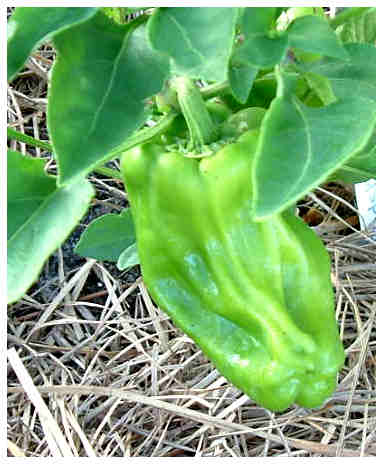Spring 2016 Garden — What’s Growing?
I think I’ve got my lineup set for this year, pepper-wise. I am probably growing far more than I should, and will be overloaded with fruit, but I have neighbors who wouldn’t mind a few peppers from time to time. So what’s in store for 2016?
Fear the Reaper
I have a post where I describe my showdown with the Ghost, Scorpion and Reaper peppers. This is a showdown that will last all year, so subscribe for email updates to keep up with what’s going on with them. But, I don’t just have them growing — let’s take a look at what else is in the garden.
Already Planted
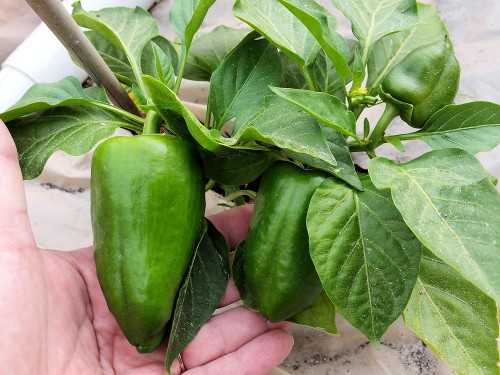
Red Bell Pepper — It Already Has 3 Peppers!
I have the following already planted out in the garden:
- Red Bell: As the name suggests, a red bell pepper — no special variety. It’s a nice compact plant that already has rather large peppers on it! I’ll actually have to pick the largest this week or next, to give the plant a chance to grow some more.
- Orange Bell: I have two of these plants, which are tall and lanky. They both have peppers on them, but I may have to give one of them a pruning, just to compare a pruned plant against an un-pruned. Seems like an interesting comparison.
- Big Bertha: Another bell pepper, and this one supposedly has huge fruit. It will be interesting to see how the fruit compares to the other bells I have growing.
- Shishito: Somewhere between a mild (no heat) and a hot. I hear that most of the fruits have no heat to them, but then every once in awhile, one of the peppers has some kick to it. It also has a pepper already — doesn’t look anything like the bells — it’s more of a small pepperonici as far as general shape goes.
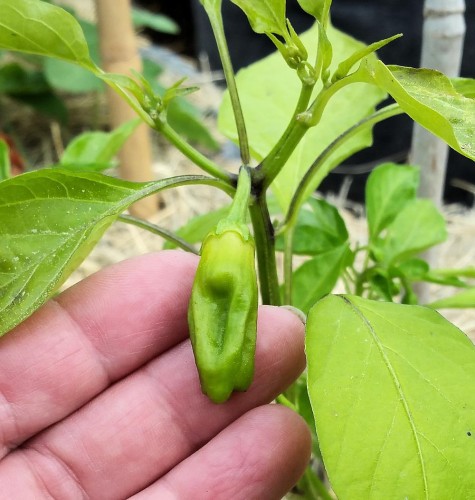
Baby Shishito Pepper
- Havasu: I had no idea what it might be like when I bought the plant start, but I figured with a name like Havasu, it was bound to be at least a little on the spicy side. I finally got around to looking it up, and it’s kind of a stubby banana pepper in shape, and a mild heat. The plant was looking kind of spindly, so I gave it a pruning and it’s coming back beautifully!
- Cowbell: I believe this is supposed to be like a thicker cayenne, along the size of my Yellow Cayenne from the last season I grew peppers. I imagine it’s probably along the same hot-ness as most cayenne fruits. I already gave this one a pruning as well, because it was really lanky. It’s coming back fine, but not as quickly as Havasu (which I pruned at the same time).
From Seed, Waiting to Sprout
Of course I have my “Showdown” peppers that I am growing from seed, but I have a few others as well:
- Jimmy Nardello: A big, sweet pepper. I grew this several years back and thought it was time that I tried it again.
- Mama Mia Giallo: The variety I am growing ripens to yellow, and is supposed to be very sweet. And also quite large!
- Fooled You: This is the no-heat jalapeno I grew in the greenhouse, that succumbed to the black mildrew (or whatever it was). Since I am growing it with better air circulation this year, it should be fine. The peppers were tasty!
- Trinidad Perfume: This one is a no-heat habanero! I figure I have enough Scoville growing this year, with the showdown plants, that I will need some respite! 😉
I might also grow Giant Aconcagua; still trying to decide. I grew that one a few years back as well and it really does produce extremely large peppers for me. I guess it depends on if I have enough space in the garden. I still have a lot of tomatoes, not to mention some strawberries, cukes, summer squash, bush beans, peas, collards and honeydew.
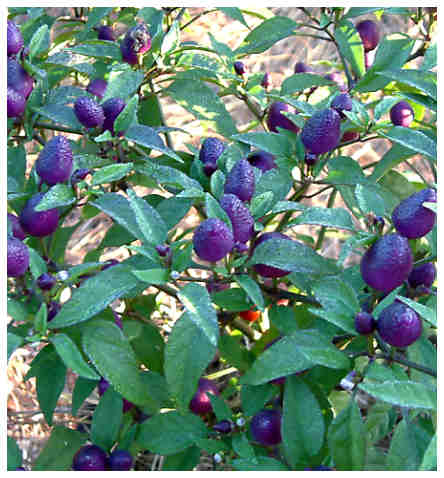 Tri-Fetti is also on the list; it’s an ornamental pepper that I grow mostly for the foliage, which is lovely. That I know I have room for, at the edge of the garden where I have the flowers. The changing leaf colors are pretty by themselves, but the purple (and then red) peppers add more of an interest. They don’t grow very large, so I can keep them in a 3 gallon pot without an issue. (At any rate, it’s smaller than the Pretty Purple Pepper that I grew a few years back, pictured on the right.)
Tri-Fetti is also on the list; it’s an ornamental pepper that I grow mostly for the foliage, which is lovely. That I know I have room for, at the edge of the garden where I have the flowers. The changing leaf colors are pretty by themselves, but the purple (and then red) peppers add more of an interest. They don’t grow very large, so I can keep them in a 3 gallon pot without an issue. (At any rate, it’s smaller than the Pretty Purple Pepper that I grew a few years back, pictured on the right.)
Now that I think of it — I won’t have a ton of room! But one of the tomatoes is a determinate, so that space should be available by the time the peppers I’ve planted from seed are ready to move outside. The container with the peas (which is 25 gallons) will also be available – I can easily put two pepper plants in there. The collards will also be done, so two more containers!
Anyway, I’ll be providing updates, so stay tuned. As more of the peppers start producing, I’ll start doing some video walk-throughs as well.
Catch up more with you later!
Planting Pepper Seeds
Planting pepper seeds is pretty easy. Sure, all you need to do is put the pepper seed in soil, cover it and water it, but there are a few more steps along the way that can up the germination rate of your pepper seeds. Let’s take a quick look.
Seed-Starting Medium
I can’t remember the last time I planted a pepper seed outdoors, directly into the soil. The germination rate is really poor that way, and seed-starting medium (“soil”) is a much better bet.
Go to your local garden center and locate some seed-starting soil. You can use straight sphagnum moss (finely chopped) or sphagnum and vermiculite combined, if you can’t find a ready-made seed-starting medium.
Do not use garden soil directly; there are too many bacteria, spores and whatnot in it; fine for older transplants, not so great for seeds.
Containers for Planting Seeds
You’ll see in the two videos that I’ve used plain paper cups (“Dixie cups”) for my containers. Cheap and easy to find, you can poke holes in the bottom for drainage, and when it comes time for planting, the cup tears away from the soil very easily.
Planting Pepper Seeds Videos
Here are two videos I made on planting pepper seeds. The first one goes over supplies; the second is the actual technique. And after the second video, I’ll list where you can get some of the supplies online, if you can’t find them locally.
Enjoy!
And here’s part 2 of how to plant pepper seeds.
Redskin Pepper in the Garden
I decided to try the Redskin pepper, even knowing my track record with bell peppers hasn’t exactly been stellar. But I have to admit to being impressed with Redskin. Finally, a bell pepper that actually produces for me in South Florida!
Planting Redskin Pepper
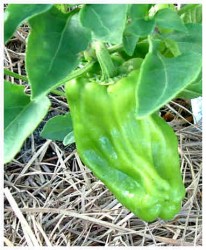 I had to plant this versatile pepper from seed, as there were none in the local garden shops.  The plant started out a little spindly at first, but started growing nicely once in the garden.
I had to plant this versatile pepper from seed, as there were none in the local garden shops.  The plant started out a little spindly at first, but started growing nicely once in the garden.
Given my luck with bell peppers, I planted 4 Redskins, hoping at least 1 would produce some peppers. Whoa! They all are producing nice little bells.
Now Redskin doesn’t grow as large as traditional bell peppers, but it’s a great “personal size” snack. My peppers are around 4″ long and maybe 2.5″ wide. The taste is quite pleasing, even when green. And speaking of color, this pepper is red when fully ripe.
Low-Growing Pepper
This pepper is a low growing pepper — wider than it is tall. This makes it fantastic for growing in containers! In fact, I have 3 of my Redskins in containers and only one in the ground (and yes, they do grow a bit taller in the ground).
For someone who traditionally cannot grow bell peppers, this one is thriving and gets an “A” in my book! Looks to me like I will have plenty this year. So if you’ve been having problems growing bell peppers, this is one variety I recommend you trying.
